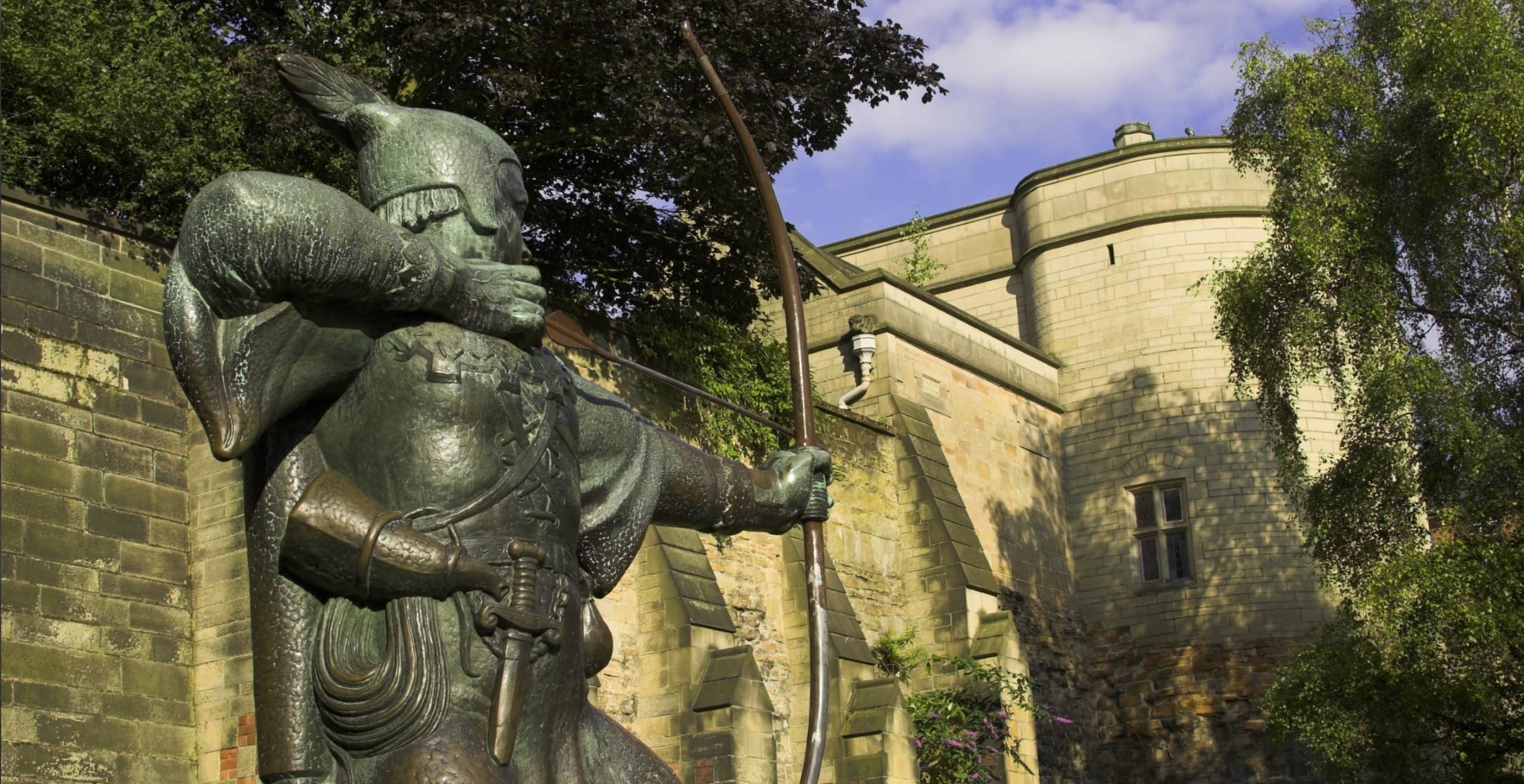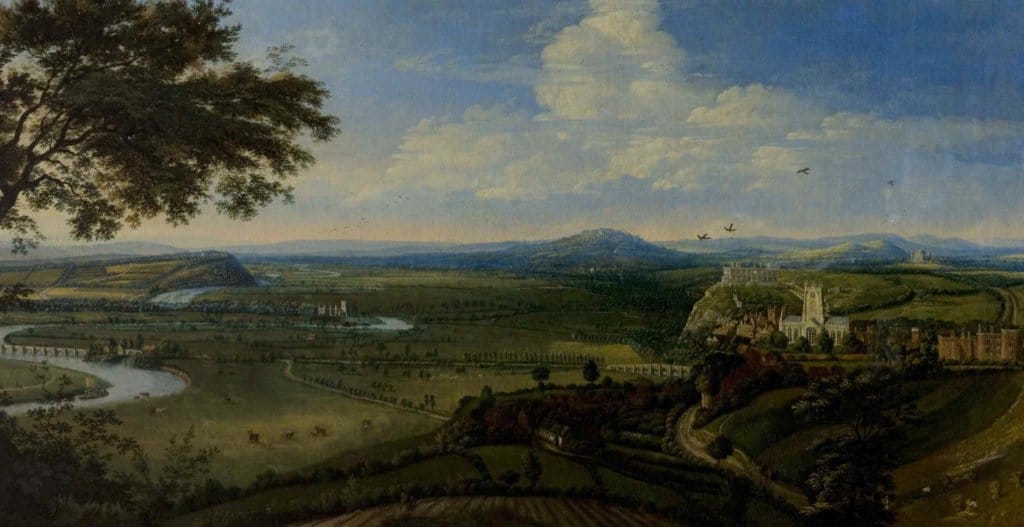What do you know about Nottingham? Many people would give an answer we are all familiar with – Robin Hood of course.
If you visit Nottingham today, you will find Robin Hood in all his glory, depicted in statue form, standing proudly in front of the city’s castle walls. But Nottingham is not just about Robin Hood: the city has a great cultural and historic heritage hiding behind its modern-day structures.
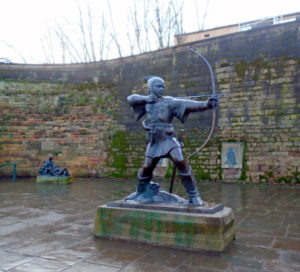 Robin Hood statue. Image © Jessica Brain.
Robin Hood statue. Image © Jessica Brain.
Located in the East Midlands, Nottingham began life as a minor settlement in the 6th century known as Snottingham, the name later evolving to become the more familiar Nottingham.
Over time, the settlement began to expand, developing into a town in the 9th century as the Danes turned Nottingham into a burgh with a defensive ditch surrounding it. By 920, when it was back in the hands of the English king, a bridge had been built in order to cross the River Trent.
In the centuries that passed, Nottingham would continue to grow in size and population. In 1067, William the Conqueror chose to build a castle in order to guard the city. Of course, this preliminary structure was constructed from wood and adopted a typical motte-and-bailey design. It was soon to be replaced in the following centuries with a more secure design using stone as instructed by the now reigning monarch, King Henry II.
The castle commanded a notable presence in the area and was well-known in its heyday as one of the best strongholds in the country. Sadly, today there is little remaining apart from some of the foundations and outer walls.
Nottingham Castle occupies an impressive elevated position upon what is known as “Castle Rock”, with some cliff faces reaching around 40 metres high. The medieval castle consisted of an upper bailey as well as a large outer bailey and royal apartments, as it served not only as a fortress but also as a royal residence.
In the time of Richard the Lionheart, it also became the setting for a dramatic showdown between King Richard I and his brother and enemy, Prince John. Whilst the king had been away, participating in the Third Crusade, his rival Prince John and his supporters had decided to occupy the castle.
Upon his return from fighting abroad, the castle found itself in the firing line when in March 1194 Richard the Lionheart besieged the structure, operating the use of makeshift siege machines which had become a feature of the crusade battles. With the support of important members of the nobility, Richard ensured that John and his rivals surrendered the castle only a few days into the siege.
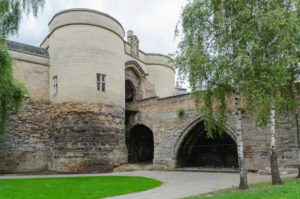 Nottingham Castle. Note the the medieval bridge and lower towers, with the Victorian renovations above.
Nottingham Castle. Note the the medieval bridge and lower towers, with the Victorian renovations above.
In the medieval period, the drama surrounding the castle continued when King Edward III in October 1330 decided to stage a coup d’état against his own mother, Isabella of France. In dramatic events which unfolded in the dead of night, a secret tunnel was used by Edward’s accomplice Sir William Montagu and others to enter the castle surreptitiously. Upon entering the royal residence, Isabella’s lover, Roger Mortimer, Earl of March was captured and later executed for treason. Isabella was sent into seclusion from public life.
King Edward III would use Nottingham Castle as his residence as well as holding parliaments there. The castle was expanded under his ownership, acquiring a new tower and even a prison, which in 1376 was used to incarcerate the Speaker of the House of Commons, Peter de la Mare.
In the following centuries the castle fulfilled varying functions both as a royal residence and a military base. During the reign of King Henry VII it was further fortified.
After years of royal control and various additions and changes being made to the structure, in the 16th century the castle fell into ruin, with large sections being demolished. The decline saw the site rebuilt as a mansion by Henry Cavendish, 2nd Duke of Newcastle who built largely on the castle’s old foundations.
Two centuries later the mansion was burned down by rioters and once more the residence was reconstructed to become an art gallery and museum in testament to the rich history of the site.
Whilst the ruins of Nottingham Castle remain a prominent reminder of the city’s historical significance, other equally historic places are hiding in plain sight, none more so than the “Ye Olde Trip to Jerusalem”, reputed to be the oldest pub in England.
Sadly for the establishment, its historic claims have not been verified by evidence and it faces several other challengers across the country for the title of “oldest pub”. Nonetheless, this historic building is believed to date back to around 1189. “Ye Olde Trip to Jerusalem” is thought to have originally been used a brewhouse for the castle before becoming an inn, known initially as “The Pilgrim”, but by 1799 it had adopted a new name, “Ye Olde Trip to Jerusalem”, believed to have originated from the use of the inn by pilgrims as well as crusaders about to embark on an epic journey to Jerusalem.
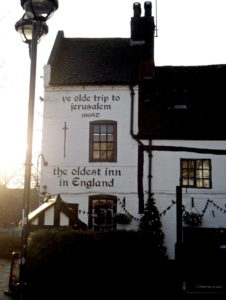 Ye Olde Trip to Jerusalem pub. Image © Jessica Brain.
Ye Olde Trip to Jerusalem pub. Image © Jessica Brain.
Often referred to colloquially as simply “the Trip”, the historic pub is nestled against Castle Rock, overshadowed by the castle’s walls. The building itself is connected to a network of sandstone caves. Much of the pub’s structure itself dates from the 16th century but it is still connected to the medieval caves which are accessible via the beer cellars, allowing access beyond the castle walls.
These caves form a very important part of the city’s heritage and date back to around 1250. In fact, Nottingham retains the title of the city with the most manmade caves, with a vast and impressive network spread out beneath the modern city.
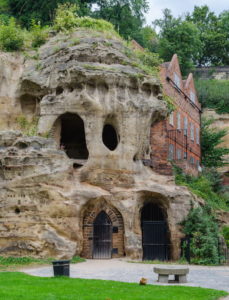
The primary function of these medieval caves was shelter for the poorer residents of the city. As the caves provided much needed sanctuary, the homes began to grow and expand much like the urban sprawl of the city, but simply underground.
Centuries later, people continued to inhabit the caves and they quickly became the epicentre of the burgeoning tanning industry during the Industrial Revolution. Over time, the necessity for these caves dwindled and instead they became a useful place in which to store items. However it is believed that the last family to occupy a cave was as late as 1924.
During the Second World War, the caves fulfilled an essential function as air raid shelters. Today, they are now more of a tourist attraction, with visitors able to explore the underground origins of the city.
As the settlement of the city continued to grow and expand, so too did the development of industry in the region. Whilst the medieval period had been dominated by the wool industry, by the 16th century its levels of production had fallen into decline and it was replaced by a more profitable industry, lace.
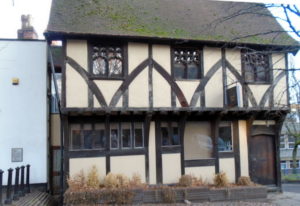 Nottingham Lace Centre. Image © Jessica Brain.
Nottingham Lace Centre. Image © Jessica Brain.
In the 17th century, the lace industry thrived in Nottingham and today the Lace Market is an historic area of the city. At the height of its popularity and success, during the boom years of the British Empire, the lace industry based in the East Midlands was expanding and developing with vast warehouses and salesrooms, storing, producing and displacing the goods. Today it is a protected heritage area, paying tribute to the city’s industrial past.
In the 18th century the famous writer Daniel Defoe, the creator of “Robinson Crusoe” is reputed to have remarked that Nottingham was “one of the most pleasant and beautiful towns in England”, a fitting tribute to a city steeped in history.
Jessica Brain is a freelance writer specialising in history. Based in Kent and a lover of all things historical.
Want to explore Nottingham? We recommend the Nottingham Self Guided Tour.
